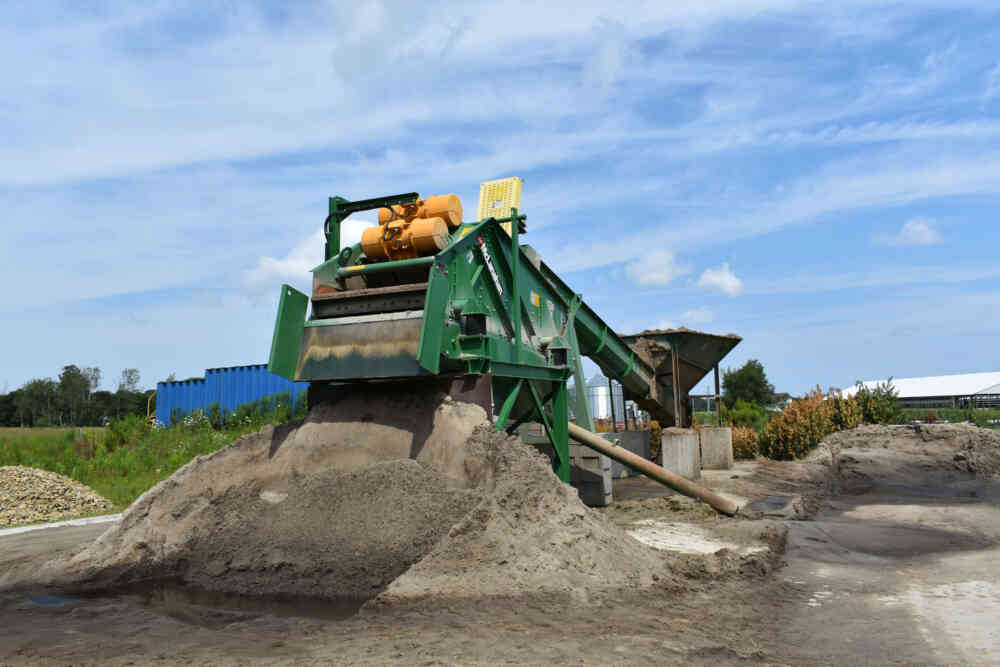Bedding choice plays a critical role in cow comfort and herd health, especially when it comes to maximizing milk quality and production. There are different options when it comes to choosing your bedding type, but for many dairy farms, sand remains the top choice for bedding material. Sand is considered the gold star bedding material because of its many benefits, including being the best bedding type for cow comfort. Sand is an inorganic material, so it doesn’t promote the growth of mastitis-causing bacteria. It drains well and will keep cows cleaner and drier for longer. Sand also provides traction to reduce potential foot and joint injuries and can provide a cooling effect in hot weather.
Within the conversation that surrounds sand, one question that often comes to the forefront: Is new sand or recycled sand the better option?
Benefits of Recycled Sand
With recycled sand, there can be concerns about cleanliness, consistency and bacteria counts. Properly recycled sand has no problem in these areas. In fact, recycled bedding can be equal to, if not better in some cases, at providing the same benefits that sand bedding in general is known to provide. These benefits include:
- Cow comfort: Properly recycled sand retains the same cushion and form as new sand. Sand manure separation systems will remove debris and excessive fine particles, ensuring comfort based on cleanliness and particle size. Recycled sand also provides the same traction as new sand and reduces the potential for foot or joint injuries.
- Low bacteria growth: Studies show that recycled sand has no significant difference in bacterial counts compared to new sand after filling the stalls.
- Moisture and organic matter: The ideal sand bedding moisture range is 4-5%. Both new and recycled sand typically fall within this range when processed properly. Additionally, depending on where new sand has been sourced and if it was screened and rinsed prior to being delivered, recycled sand may have lower organic materials and contain less debris. Minimizing moisture will help keep cows and their bedding clean and dry and eliminate bacteria growth.
Bedding cost: Purchasing new sand is expensive over time due to material and transportation costs. Assuming 50lbs of sand per cow per day is used on a 1,500- cow dairy and that new sand costs $15 per ton, recovering 90% of sand adds up to $205,313 annual savings! For many dairy farms, recycling sand bedding can offer a sustainable way to retain the benefits of bedding with sand and maintain good cow comfort and health. Recycling sand bedding can help reduce the expenses that come with new sand, including trucking, manure management, and equipment wear and tear. It can also reduce costly storage tank cleanouts and keep equipment running efficiently by reducing the amount of sand-laden manure that is pumped throughout the system.
Mechanical sand separation systems that include Agricultural Hydrocyclones and additional sand settling lanes often recover up to 98% or more of sand from manure, with the remainder lost as fine particles.
New Sand Bedding Challenges
There are assumptions that new sand is always the better option, but new sand can also come with its own challenges. Depending on the source of the sand, quality, organic matter and particle sizes can vary between loads. New sand, unwashed sand from local pits can contain nonideal levels of silts, clays and plant debris. Sand that contains too many silts or clays will pack too easily in the stall, reducing cow comfort and increasing the chance for joint injury. To ensure that new sand will be compatible with your equipment or a sand reclamation system, testing on sand composition is essential.
High-quality sand, new or recycled, should always include a proper mix of fine and coarse grains, as well as minimal gravel, clay and silt to provide proper drainage, traction and cushion to keep cows comfortable.
Management Matters
Regardless of sand origin and whether you bed with new or recycled sand, proper stall management is one of the most important factors in successfully bedding with this material. When bedding on sand, the sand in the stall should be higher in the front and slope downward toward the curb at the back of the stall. Sand should always be at least 6”-8” deep, and new sand should be added at least once per week. Regular stall grooming will keep the sand loose and comfortable for the cows, as it’s important to maintain a full bed of clean and dry sand. It’s recommended to groom the stalls every time the cows leave the pen to head to the milking parlor.
Conclusion
Whether you plan to recycle or buy new, the quality of your sand if of the upmost importance. Research continues to show that recycled sand provides the same quality as new sand, when processed and recycled properly. Compared to new sand, recycled sand can reduce bedding costs, will have consistent quality with proper separation, contain optimal moisture levels around 4-5%, and will be a constant supply that is quality controlled.
Ultimately, choosing to bed stalls with new or recycled sand will come down to the economics, logistics and long-term goals of your individual farm.





